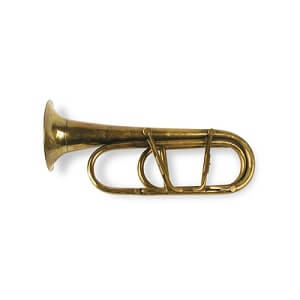Keyed Trumpet
 The natural trumpet was notoriously difficult to play, particularly in regard to playing the notes in the upper register. In order to facilitate easier playing, keys were added to the trumpet in 1796 by Anton Weidinger. Joseph Haydn, a friend of Weidinger composed his Trumpet Concerto in E flat major to demonstrate the ability of the new keyed trumpet. Although more flexible than the natural trumpet, keyed trumpets had a poor sound quality and they were replaced by trumpets with valves.Several players in the 18th century experimented with adding keys to the trumpet, the most successful being Anton Weidinger, for whom Haydn wrote his trumpet concerto (for keyed trumpet in Eb). The instrument was extensively used in the first half of the 19th century, until it was ousted by valved trumpets(on the continent) and slide trumpets (in Britain). The keys are opened one at a time, not as on the keyed bugle. Lent by A. Myers.
The natural trumpet was notoriously difficult to play, particularly in regard to playing the notes in the upper register. In order to facilitate easier playing, keys were added to the trumpet in 1796 by Anton Weidinger. Joseph Haydn, a friend of Weidinger composed his Trumpet Concerto in E flat major to demonstrate the ability of the new keyed trumpet. Although more flexible than the natural trumpet, keyed trumpets had a poor sound quality and they were replaced by trumpets with valves.Several players in the 18th century experimented with adding keys to the trumpet, the most successful being Anton Weidinger, for whom Haydn wrote his trumpet concerto (for keyed trumpet in Eb). The instrument was extensively used in the first half of the 19th century, until it was ousted by valved trumpets(on the continent) and slide trumpets (in Britain). The keys are opened one at a time, not as on the keyed bugle. Lent by A. Myers.
Brass; with garland; two coils (small and large). Five keys arranged for left hand operation, two on bridges across instrument; with tonehole chimneys, the fifth of which is on a ferrule. The instrument could be used with a shank for F but no shank was supplied with this instrument. With crooks (913a) for E at A?=|440|Hz, (913b) for E? at A?=|440|Hz, (913c) for E? at A?=|430|Hz, each with slide fitting to instrument for tuning, a ligature screw restraint with knurled head is mounted on crook receiver on body.
There will always be people who will try and overcome such limitations, however. Anton Weidinger-an outstanding Viennese trumpeter of the Classical period-was one such man. By adding keys to the tube, he devised an instrument that could play semitones. Weidinger requested a number of composers to write concertos for this new trumpet. Two that complied with his wishes were Joseph Haydn and Johann Hummel. Although Weidinger's keyed trumpet was rendered obsolete by the appearance of the more functional valve trumpet in the mid-nineteenth century, it was due to his unquenchable spirit of enterprise that the two greatest trumpet concertos in classical music came to be written.